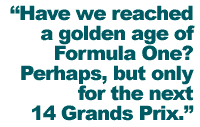

| The Changing Grid |
|
|
| by Paul Rushworth, England |
 Was it just my imagination last weekend, or did we finally have the
sort of race that Formula One justly deserves?
Was it just my imagination last weekend, or did we finally have the
sort of race that Formula One justly deserves?
I spent the weekend enjoying coverage of the Grand Prix, followed by the CART race from Long Beach and highlights of the inaugural race of the new FIA GT Championship. I can honestly say, and perhaps to my own surprise, the best race of the weekend was with no doubt the Grand Prix of Argentina.
Many may disagree with this statement, but it can not be denied that CART and racing itself has outgrown the Long Beach circuit. I cannot recall the last time a CART race had such little overtaking, an attribute the series prides itself on. While the GT Championship has attracted a huge and immaculately prepared field, the cars became spread out, and a war of attrition was the theme of the day... as is the way the majority of endurance racing.
Have things really changed in Formula One though? After all, a Williams did claim their second win of the season. However, it was by barely a second. Would Williams have won had Oliver Panis or Michael Schumacher not retired so early on? I must admit that Eddie Irvine deserved his result, but on qualifying pace both the Prost and the other Ferrari should have been ahead of him at the finish. Furthermore, consider this: after racing nearly 305 kilometers, the podium was separated by slightly over 12 seconds. The 4th, 5th and 6th place drivers were within 1.5 seconds of each other. Just how long has it been since racing was this close?
Perhaps more interesting is to look at the spread of the grid. Qualifying has long been considered the true indication of pace. In 1995, the first year of the Autodromo Oscar Alfredo Galvez in it's current guise, the grid was separated by a massive 112%. If the 107% rule had been around in 1995, Messieurs Gachot, Moreno, Diniz and Inoue would have found themselves heading home for a shower mid Saturday Afternoon. In 1996, the grid scraped inside the 107% barrier. In 1997, the grid was spread with 105% of the pole position time -- In Brazil it was a startling 104%. Have the teams at the front lost their advantage or have other factors come into play?
The immediate answer that comes to mind is that the new rubber supplied by Bridgestone, supplied largely to teams at the middle or back of the grid, has provided the surge in performance for the respective teams. Yet Tyrrell, still supplied with Goodyear rubber, have moved slightly closer to the benchmark set at the front of the grid. With laps time nearly 6 seconds faster than last year and all competitors qualifying well within Damon Hill's 1996 pole, the new speed must be derive from the tires and increased mechanical grip provided by them.
Aerodynamic grip is still just as crucial. If the Williams needs a set amount of grip at a given corner, it can now rely less on grip from the wings, as and such achieve higher straight-line speeds. For a less effective car aerodynamically, the performance difference would still remain.
So why has the field closed up? Change perhaps. Or a lack of it.
For the first time since the beginning of 1992, the Formula has remained relatively unchanged technically at the beginning of a season. Formula One has seen changes in tire width, electronic systems, engine size, cockpit protection and dozens of other minute changes. What has long been suggested appears to be true; the larger teams can adapt to change the best via greater skill and testing time via their backing. The smaller teams have to adapt at a less frenzied pace.
Have we reached a golden age of Formula One? Perhaps, but only for the next 14 Grands Prix. In 1998, drastic changes are set to sweep Formula One yet again.
1998 will see the "slick" groveless tires are to be replaced with a new tire which will have two groves cut into its circumference. The width of the current Formula One car will be reduced in the order of 20cm, leaving it barely 5cm wider than a current Formula 3 car. Reducing the mechanical grip of the car by providing less grip from the tires is only going to heighten the importance of aerodynamic grip. Championship leader Jacques Villeneuve said recently "mechanical grip is always better than aerodynamic grip. It allows you to fight better and stay closer to someone.. the other thing is that a smaller, narrower car will be too efficient down the straight. The drag won't be big enough to create a vacuum, so you won't be able to get a tow."
Yet again, Formula One seems intent on change and while the competition at the front will no doubt adapt with ease... further down there will be slips in the field as other teams attempt to catch back up.
How long will it take will it take for this to happen? For your sake and mine, hopefully before more changes are made…